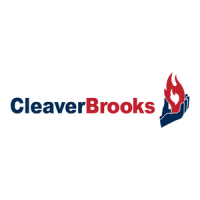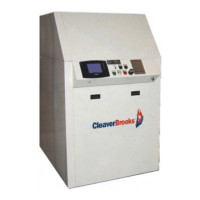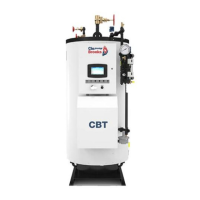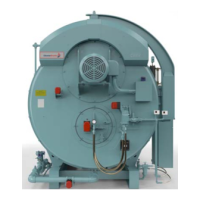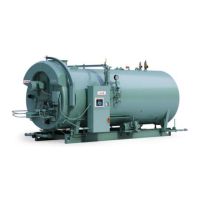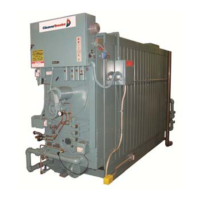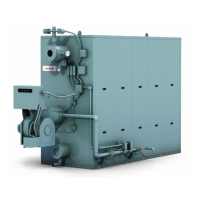CFC-E Installation Manual
1-6 Part No. 750-459
1.2 - Boiler Room Requirements
The boiler room must comply with all building codes and regulations. An adequate supply of combustion
air is required for safe operation.
Clean combus
tion air is required for optimum efficiency and boiler operation. Dust and airborne
contaminants will adversely effect burner performance. If conditions dictate, a serviceable filter must be
placed in the intake piping to eliminate airborne contamination to the burner. An optional air filter is
available from Cleaver-Brooks. Additionally, if a direct vent combustion air intake is used the intake
should be directed to eliminate rain or snow from entering the intake piping. The boiler must be installed
so that the gas ignition system components are protected from water (dripping, spraying, etc.) during
appliance operation and service.
The boiler room should have adequate ventilation and should be at positive pressure.
The flue gases from the Model CFC-E boiler should be removed via a gas-tight, temperature and
corrosion resistant flue gas pipeline. Only flue gas systems approved and tested by the relevant region
or province are to be connected to the boiler. Refer to flue piping manufacturer for proper installation
and sealing instructions.
See also Section 2 of this manual for combustion air and flue gas venting requirements.
1.3 - Water Treatment
Cleaver-Brooks ClearFire
®
condensing boilers are suitable for closed loop heating systems. Systems
with significant air accumulation due to unknown or unseen leaks
must be equipped with a system air
separation or pretreatment device.
Untreated drinking water is generally the best heating medium as filling and make-up water for a system
that utilizes the Model CFC-E. If the water available from the main s
ystem is not suitable for use, then
demineralization and/or treatment with inhibitors is necessary. Treated filling and make-up water must
be checked at least once a year or more frequently if so specified in the application guidelines from the
inhibitor manufacturer.
Those parts of the boiler in contact with water are manufactured with ferrous materials and corrosion-
resistant stainless steel. The chloride content of the heating water should be below 250 ppm. The pH
level should be between 8.3 and 10.5 after six weeks of operation.
Table 1-2 gives recommended CFC-E water chemistry parameters. Adherence to these limits will help
to maintain efficiency and will aid in preventing overheating of the boiler's heating surfaces.
Water make-up during the lifetime of the boiler should not be greater than 3 times the system volume.
A water meter should be installed on the feed line to monitor makeup water volume.
1.3.1 - New Installations
A new hydronic system may contain various kinds of debris from the construction process, including
weld slag, metal shavings, etc. The piping system should be thoroughly flushed with the boiler
isolated from the system to ensure particulates do not enter the boiler.
During this and any subsequent cleaning or flushing of the system, take care to ensure that no debris
enters the boiler during the cleaning process. Consult with the installation contractor and/or water
treatment provider for filtration recommendations.
Table 1-1: Boiler Room Requirements
Boiler room
environmental
requirements:
Temperature Range 32 to 122 deg F
(0 to 50 deg C)
Humidity 85% maximum relative humidity non-condensing
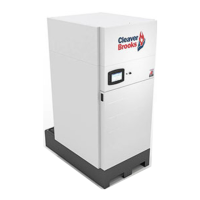
